NavSource Online: Submarine Photo Archive
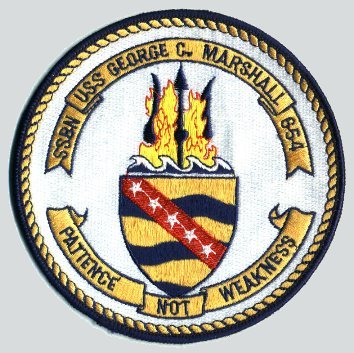
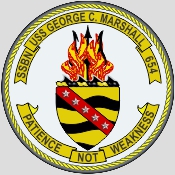
Patch on left contributed by Mike Smolinski, Decal on right by unlimiteddetails.com
Please report any broken links or trouble you might come across to the Webmaster.
Please take a moment to let us know so that we can correct any problems and make your visit as enjoyable and as informative as possible.


| Click On Image For Full Size | Size | Image Description | Source | |
|---|---|---|---|---|
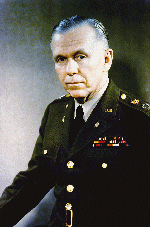 | 96k | George Catlett Marshall (31 December 1880- 16 October 1959), America's foremost soldier during World War II, served as chief of staff from 1939 to 1945, building and directing the largest army in history. A diplomat, he acted as secretary of state from 1947 to 1949, formulating the "Marshall Plan", an unprecedented program of economic and military aid to foreign nations. Marshall's father owned a prosperous coal business in Pennsylvania, but the boy, deciding to become a soldier, enrolled at the Virginia Military Institute from which he was graduated in 1901 as senior first captain of the Corps of Cadets. After serving in posts in the Philippines and the United States, Marshall was graduated with honors from the Infantry-Cavalry School at Fort Leavenworth in 1907 and from the Army Staff College in 1908. The young officer distinguished himself in a variety of posts in the next nine years, earning an appointment to the General Staff in World War I and sailing to France with the First Division. He achieved fame and promotion for his staff work in the battles of Cantigny, Aisne-Marne, St. Mihiel, and Meuse-Argonne. After acting as aide-de-camp to General Pershing from 1919 to 1924, Marshall served in China from 1924 to 1927, and then successively as instructor in the Army War College in 1927, as assistant commandant of the Infantry School from 1927 to 1932, as commander of the Eighth Infantry in 1933, as senior instructor to the Illinois National Guard from 1933 to 1936, and as commander, with the rank of brigadier general, of the Fifth Infantry Brigade from 1936 to 1938. In July, 1938, Marshall accepted a post with the General Staff in Washington, D. C., and in September, 1939, was named chief of staff, with the rank of general, by President Roosevelt. He became general of the army in 1944, the year in which Congress created that five-star rank. In his position as chief of staff, Marshall urged military readiness prior to the attack on Pearl Harbor in 1941, later became responsible for the building, supplying, and, in part, the deploying of over eight million soldiers. From 1941 he was a member of the policy committee that supervised the atomic studies engaged in by American and British scientists. The war over, Marshall resigned in November, 1945. But Marshall could not resign from public service; his military career ended, he took up a diplomatic career. He had been associated with diplomatic events while chief of staff, for he participated in the conference on the Atlantic Charter (1941-1942), and in those at Casablanca (1943), Quebec (1943), Cairo-Teheran (1943), Yalta (1945), Potsdam (1945), and in many others of lesser import. In late 1945 and in 1946, he represented President Truman on a special mission to China, then torn by civil war; in January, 1947, he accepted the Cabinet position of secretary of state, holding it for two years. In the spring of 1947 he outlined in a speech at Harvard University the plan of economic aid which history has named the "Marshall Plan". For one year during the Korean War General Marshall was secretary of defence, a civilian post in the U. S. Cabinet. Having resigned from this post in September, 1951, three months before his seventy-first birthday, he retired from public service, thereafter performing those ceremonial duties the public comes to expect of its famous men. | Defense Visual Information Center Photo # DA-SD-05-00593 courtesy of dodmedia.osd.mil. & submitted by Bill Gonyo. Text courtesy of nobelprize.org. | |
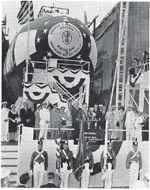 | 740k | Distinguished speakers at the Launching ceremony for George C. Marshall (SSBN-654) on 21 May 1965. | Photo courtesy of Dale Hargrave. | |
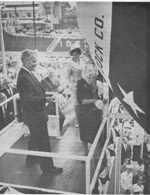 | 1.10k | Mrs. George C. Marshall gives her husband's nuclear namesake, George C. Marshall (SSBN-654) something to drink before it appears in such on 21 May 1965. | Photo courtesy of Dale Hargrave. | |
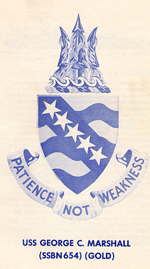 | 1.38k | Fifteen page PDF Welcome Aboard pamphlet for the George C. Marshall (SSBN-654). | USN photo courtesy of Scott Koen & ussnewyork.com | |
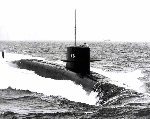 |
153k | Pre-commissioning photo of the George C. Marshall (SSBN-654), underway off the coast of Newport News, VA., 31 March 1966. | USN photo courtesy of pelicanharborsubvets.com. | |
 |
18k | Commemorative post mark on the occasion of the commissioning of the George C. Marshall (SSBN-654), at Newport News Shipbuilding and Dry Dock Co., Newport News, VA, 29 April 1966. | Photo courtesy of Jack Treutle (of blessed memory). | |
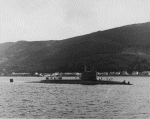 |
107k | George C. Marshall (SSBN-654), at Holy Loch, Scotland, circa mid 1970(?) | USN photo courtesy of STSCS(SS) Robert Carlin. | |
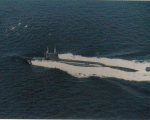 |
93k | Broadside view of the George C. Marshall (SSBN-654) underway in the Long Island Sound, 1 September 1979. | Official USN photo courtesy of Wendell Royce McLaughlin Jr. | |
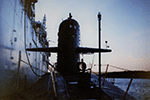 |
454k | The sun sets on George C. Marshall (SSBN-654) in Holy Loch Scotland alongside the Holland (AS-32), 1979. | Photo courtesy of Bryan Jackson. | |
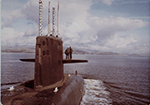 |
381k | George C. Marshall (SSBN-654) in Holy Loch Scotland, 1979. | Photo courtesy of Bryan Jackson. | |
 |
414k | George C. Marshall (SSBN-654) Manuvering Watch, February 1981. | Photo courtesy of Bryan Jackson. | |
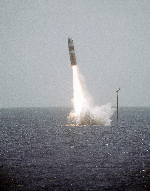 |
219k | A UGM-73 Poseidon missile is launched from the nuclear-powered strategic missile submarine George C. Marshall (SSBN-654) on 24 July 1984. | Defense Visual Information Center photo # DFS-C85-12084, courtesy of dodmedia.osd.mil. | |
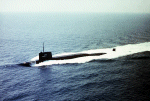 |
428k | A port bow view of the nuclear-powered strategic missile submarine George C. Marshall (SSBN-654) underway, 1 February 1991. | Defense Visual Information Center photo # DN-ST-91-05232, courtesy of dodmedia.osd.mil. | |
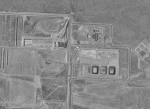 | 83k | Trench 94, Hanford Site, Washington, 1994. Hull sections containing defueled reactor compartments of decommissioned nuclear-powered submarines are put in disposal trenches. Once full, the trench will be filled with dirt and buried. The compartments are expected to retain their integrity for more than 600 years. | USN photo submitted by Jack Treutle (of blessed memory). | |
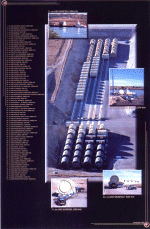 | 569k | Sealed reactor compartments are shipped by barge out of Puget Sound Naval Base down the coast and along the Columbia River to the port of Benton. There the radioactively-contaminated hull sections are transferred to special multiwheeled high-load trailers for transport to the Hanford Reservation in Washington State. Pictured below is the burial ground for spent fuel of the following 77 nuclear reactor submarines as of March 2003: Patrick Henry (SSBN-599), Snook (SSN-592), George Washington (SSBN-598), Scamp (SSN-588), Robert E. Lee (SSBN-601), Thomas Jefferson (SSBN-618), Theodore Roosevelt (SSBN-600), Dace (SSN-607), John Adams (SSBN-620), Abraham Lincoln (SSBN-602), Barb (SSN-596), Ethan Allen (SSBN-608), Thomas A. Edison (SSBN-610), Pollack (SSN-603), Glenard P. Lipscomb (SSN-685), James Monroe (SSBN-622), Skipjack (SS-585), Nathan Hale (SSBN-623), Plunger (SSN-595), Shark (SSN-591), Lafayette (SSBN-616), Sam Houston (SSBN-609), Jack (SSN-605), Haddo (SSN-604), Tinosa (SSN-606), Guardfish (SSN-612), Permit (SSN-594), Queenfish (SSN-651), Ulysses S. Grant (SSBN-631), John Marshall (SSBN-611), George C. Marshall (SSBN-654), Flasher (SSN-613), Guitarro (SSN-665), Alexander Hamilton (SSBN-617), George Washington Carver (SSBN-656), Tecumseh (SSBN-628), Halibut (SSGN-587), Will Rogers (SSBN-659), Henry L. Stimson (SSBN-655), Daniel Boone (SSBN-629), Greenling (SSN-614), John C. Calhoun (SSBN-630), Casimir Pulaski (SSBN-633), Skate (SSN-578), Sargo (SSN-583), Francis Scott Key (SSBN-657), Sturgeon (SSN-637), Benjamin Franklin (SSBN-640), Swordfish (SSN-579), Seadragon (SSN-584), Stonewall Jackson (SSBN-634), Simon Bolivar (SSBN-641), Hammerhead (SSN-663), Mariano G. Vallejo (SSBN-658) , Tullibee (SSN-597), Lewis & Clark (SSBN-644), Pargo (SSN-650), Seahorse (SSN-669), Gurnard (SSN-662), Flying Fish (SSN-673), Gato (SSN-615), Puffer (SSN-652), Seawolf (SSN-575), Baton Rouge (SSN-689), Bergall (SSN-667), Whale (SSN-638), Henry Clay (SSBN-625), James Madison (SSBN-627), Finback (SSN-670), Spadefish (SSN-668), Sunfish (SSN-649), George Bancroft (SSBN-643), Grayling (SSN-646), Pintado (SSN-672), Tunny (SSN-682), Archerfish (SSN-678), & Woodrow Wilson (SSBN-624). As time passes & more boats are retired from service and their reactors are brought here, so the numbers rise. In this photo dated November 2009, 98 nuclear submarines and six nuclear cruisers have been recycled. For an up to date view, click here | USN photo submitted by Jack Treutle (of blessed memory). Insert link courtesy of wikimedia.org |
|
| Back To The Main Photo Index | Back To the Submarine Index |
|
Problems and site related matters, E-mail Webmaster |
| This page created by Joseph M. Radigan (of blessed memory) and maintained by Michael Mohl All Pages © 1996 - 2025 NavSource History. All rights reserved. |